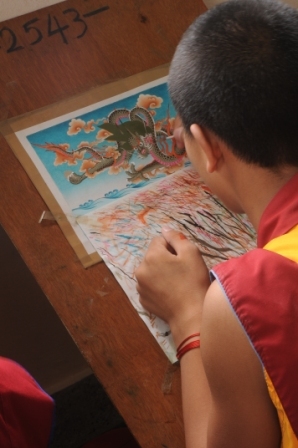Mount Everest School

Coming through the gate into the monastery, you might hear the exuberant chanting of the Tibetan alphabet by the young monks, animated classroom discussion in English, or sometimes the sound of bells and cymbals, or of prayers being recited. There is a lively atmosphere, with monks coming and going, carrying their books and school bags, just like in any courtyard in any ordinary school all over the world.
The modern curriculum combines the Nepal School syllabus and Universal Education Principles as set out by Lama Yeshe and Lama Zopa Rinpoche and based on Nepal and Indian standards, with subjects such as English, Tibetan and Nepali languages, art, math, science and social study. Mount Everest School was founded in Lawudo in 1971 by Lama Zopa Rinpoche. The school moved to Kopan a few years later, because of the difficult conditions in the mountains. Right in the beginning, the lamas recognized the importance of general knowledge and English language skills for the monks in this modern world.

There are 270 monks enrolled in the school ranging in age from 7 to 25. Classes are held from 9.30 am to 4.00 pm, during which time the monks follow a very busy schedule of classes, activities and homework.The school year has three terms, and exams are held on all subjects each term.
School attendance is compulsory up to class eleven, after which the monks can attend elective classes for another year, to train in Tibetan – English translation.
In addition to the normal school subjects the monks spend three hours every day memorizing prayers and pujas, or the texts for their philosophy class.
Three languages are taught at the school. The ability of the monks to speak several languages fluently, including their own local dialect, is a pleasant surprise to most visitors. Tibetan is studied in much depth, with emphasis on grammar and writing, as this is the language of their religious studies. All Buddhist texts, be they religious prayers or philosophy, are studied in Tibetan. Nepali, being the main local language, and English, the language of the modern world receive intensive attention as well.

A new school building was completed in 2008. It is equipped with the all the facilities to support this curriculum, such as a science and a computer lab, airy class rooms, and an assembly hall with a stage for theater performances and lectures.There is a science- and computer lab, and video room for educational videos. In the science lab the young monks can discover the hidden marvels of a drop of water, or the ability of innocuous looking fluids when combined to produce astonishing, and sometimes explosive, results. Basic computer skills are taught, especially word processing, and how to work with pictures to make simple presentations.
Great emphasis is being put on extracurricular activities such as quiz events, drama classes, essay competitions, elocution and a student debating club in three languages. Every second Sunday is set aside for these activities. Debate in English has become the latest challenge, while the younger monks engage in spelling bees, general knowledge quiz and similar activities. Debate competitions wth other schools are now part of the Sunday activities.
Towards the end of the school year a series of plays are performed, in which each class composes and presents a script according to a theme given to them by their teacher. The themes range from hilarious to profound and the skills of the young actors are astonishing.

Thangka painting has always been practised in monasteries. Nepalese and Tibetans have a great natural artistic talent, which they can hone in the thangka painting classes under the guidance of a professional thangka painter. The younger monks are first trained in drawing the various symbols common to Tibetan iconography before moving on to complex images. Their efforts are shown in an exhibition at the end of the November course where visitors can acquire these 'works of art'.
Once a year the primary school students go for an excursion, sometimes to the zoo, the botanical garden, the general fire department in Kathmandu and similar public institutions. Many of the young monks come from quite remote hill and mountain areas, and for them these excursions are the highlight of the year.
A true innovation is the inclusion of physical exercise in the school curriculum. In the monasteries in Tibet, physical exercise and games such as ball games were frowned upon. This attitude has changed as it became clear that a certain amount of physical exercise is needed to prevent serious health problems later. In the meantime the young monks play just like all small boys all over the world, playing hide and seek, and practicing their Judo high kicks. Just then the school bell rings again, and it is time to get back to the Tibetan alphabet, and math.

Recently, fire safety training has been added to the curriculum for both the monastery and the nunnery. A very kind Australian sponsor donated all the necessary firefighting equipment, even down to the safety clothes, helmets and shoes. Every year, fire training is on the schedule for the fire fighting team of both the nunnery and the monastery, practicing first aid, resuscitation, and memorizing the fire safety regulations. It is of course also great fun, as it involves putting out small to medium fires the correct way, with a lot of cheering from the spectators.
Find out how you can help the Kopan School improve the education of the monks